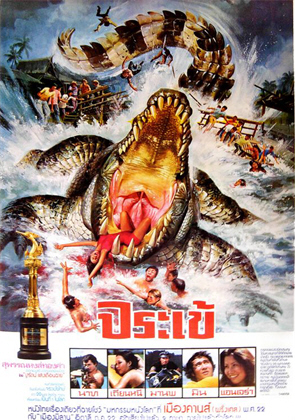
“There is an old legend which says that one day, a monster will arise from the sea, to encounter the wings of an eagle. It is the wings of an eagle I proudly wear on my chest. I believe the legend is about to come true…”
Director: Sompote Sands
Starring: Nard Poowanai, Min Oo, Kirk Warren (Manop Asawhatep), Tany Tim (Ni Tien), Angela Wells (Eun-hie Wang)
Screenplay:
Synopsis: In the wake of an atomic test, a hurricane rips apart a small Pacific island. In its wake, a gigantic crocodile slips into the ocean… A short time afterwards, in a river in Thailand, an elderly woman is dragged out of her fishing boat and killed… Angela Akom (Ni Tien) manages to persuade her workaholic husband, Dr Anthony Akom (Nard Poowanai), to take a weekend away from his hospital duties so that the two of them and their young daughter, Anne, can join Angela’s sister, Linda (Eun-hie Wang), and her new husband, Dr John Strong (Min Oo), at a beachside resort. The couples spend their time boating, swimming and resting in the sun. However, when Linda goes looking for Anne, who has been playing in the water, she cannot find her. Suddenly, Linda is pulled under the water. Angela, watching from shore, rushes into the water to help her sister. Neither one returns… In the wake of the tragedy, the authorities search, but find only fragments of Linda’s body. Dr Akom becomes obsessed with discovering the truth of the deaths, and resigns from the hospital in order to pursue his research. In a village, a group of fishermen recoil in horror when their nets bring to the surface human limbs… Dr Akom’s determination to discover the truth is fired by a newspaper article in which a fisherman claims he saw a giant crocodile in the sea. He continues to investigate, and becomes convinced that such a creature was indeed responsible for the deaths. Dr Akom asks Dr Strong to track down the fisherman, Tanaka (Manop Asawhatep), while he interviews a herpetologist who is an expert on crocodiles. Two more young women are killed while swimming. Dr Strong locates Tanaka and agrees to come to Dr Akom’s house. There he tells the others that he is willing to put his boat at their disposal, and join them in their hunt. The giant crocodile attacks a village built on the banks of a river. The result is carnage… Dr Akom receives a letter from the herpetologist, who claims that the crocodile’s size is a result of the atomic testing in the Pacific. Meanwhile, the authorities attempt to stop the crocodile by using a metal trap, but never in their wildest dreams have they imagined an animal of such size…
Comments: So with a world of alternative choices for this Roundtable – films I actually enjoy – why this sorry mess? Three reasons, none of them satisfactory in itself, but enough to activate my OCD when lumped together.


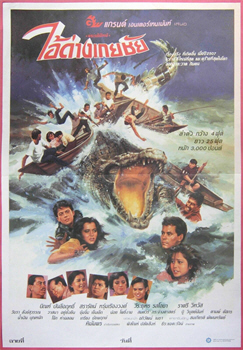
Most importantly, Crocodile is, kind of, sort of, not really but almost, the first true killer crocodilian movie; the first where the titular beastie got promoted from a mere supporting role as a villain’s henchman, or a threatening presence on a sandbank, into the central menace—and you all know how I feel about that sort of thing.
(It is more accurate to say that Crocodile is a re-working of the first true crocodilian movie, as we shall see.)
Secondly, I started working on it ages ago but then gave up on it in disgust for reasons that most of you can probably guess, and it’s been sitting near the TV ever since—jeering at me; knowing that my discomfort with leaving jobs half-done would eventually override my moral and philosophical objections to it.
Finally, I have become what you might describe as exasperatedly obsessed with trying to pin down the production and distribution history of this rather Frankensteinian work, and I don’t want the ridiculous amount of time I’ve invested to go to waste.
Not much of a recommendation, is it?
I have a working theory of Crocodile’s history, but very little of it is set in stone, and I am happy to stand corrected on any point if anyone knows better. As far as I can tell, the project began life as a Thai-Korean co-production in 1977; and although in later years this film is invariably listed as having been directed by Sompote Sangduenchai – better known to Western film-watchers as Sompote Sands – it appears that the original version, though set in Thailand, was the work of the Korean director, Won-se Lee, from a screenplay by his compatriots, Su-jung Yeo and Yeol Yu; while Sands provided the special effects. There are suggestions that the film may also have had financial input, at least, from Japan and Hong Kong.


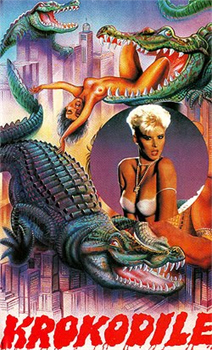
This first version of the film was certainly released in South Korea during 1978; and while it is generally called Agowa Gongpo, sources suggest that a better rendering of the title might be Ag-Eo-Ui Gongpo (roughly, Horror Of The Crocodile); though it can also be found under the rather amusing variant, Crocodile Fangs. Some time later, a version – possibly the same version – was released in Thailand under a title variously listed as Jorrakay / Chorake / Chorakhe, which I imagine is a phonetic translation of the Thai word for “crocodile”.
Then Dick Randall entered the picture.
Recently, the original Thai cut of Jorrakay has surfaced (without English subtitles), and those who have viewed it report that while it is a better film than Crocodile (no great stretch), it is also longer and slower-paced, with more emphasis on character scenes built around Dr Akom trying to cope following the slaughter of his family.
This verdict goes a long way towards explaining what happened next. Dick Randall was one of the more cheerfully shameless figures in the world of exploitation, being responsible for such epics as The Wild, Wild World Of Jayne Mansfield, The Clones Of Bruce Lee, For Y’ur Height Only and The Erotic Adventures Of Robinson Crusoe, to give only a cross-section of his activities. It is not difficult to imagine that while Randall was attracted to the idea of a film featuring a giant crocodile chewing its way across South-East Asia, the thought of a slower-paced, more emotionally driven story would have been anathema to him.
Consequently, Randall struck a deal with Sompote Sands to create something more appropriate for an exploitation audience. What Sands came up with was a cut-together, hodge-podge epic that Jerry Warren or Godfrey Ho might have been proud of.

At least two versions of Crocodile were subsequently released: one is that with which most of us are familiar today, and which was distributed by Herman Cohen (it opened in US cinemas in November of 1981, hence the choice of date for this piece); the other, usually called the “international” version (although it seems to have played some US drive-ins, as well), is slightly longer and features more nudity and gore. Most famously, it opens with a gratuitous and completely out-of-place scene in which the giant crocodile (not yet created by atomic mutation) chows down on two topless young women. The former cut became the American video, and subsequently DVD, version; while the latter was marketed in Europe and Asia—carrying in Japan the glorious title, Giant Crocodile Bloody Destroyer.
As far as we can tell, Crocodile differs from Jorrakay in a number of significant ways. It is shorter, and does indeed downplay the emotional agonies of Dr Akom in favour of more scenes of slaughter and mayhem. The crocodile’s lengthy attack upon a village situated on a river, which was the centrepiece of Jorrakay, is here cut up and turned into two different attacks on two different villages (meaning that we get to watch the same people die twice).
Furthermore, the film opens with disaster-movie-type footage lifted from another production for which Sompote Sands provided the special effects, Pandin Wippayoke aka Paen Din Wip-Pa-Yok, which was made in 1978. It also features randomly inserted pieces of mismatched crocodilian stock footage: “crocodilian”, inasmuch as some of the inserted critters are alligators; is dubbed into English in a way that markedly increases its humour quotient; and favours a style of editing that might reasonably be called “whiplash”. Finally, the identity of the person who succeeds in killing the beast changes, which probably explains the ambiguity noted below.
There are Jaws riffs to be seen in Crocodile, which is not surprising; while it seems to me that Orca may have been something of an influence, too; which is all to the good. Unfortunately, between the editing, which is literally headache-inducing, and the number of effects sequences that play out in the dark, it is often frustratingly difficult to actually see what’s going on in this film (let alone take decent screenshots of it).

(Oh, yeah: Piranha, she thought guiltily…)
For most viewers—strike that, all viewers of Crocodile, its positive highlight is the first deployment of Sompote Sands’ cherished giant crocodile model, which subsequently reappeared in a number of films with which he was involved, including Krai-Thong and King-ka Kayasit aka Magic Lizard.
The negative highlight is that it features two completely unnecessary and nauseating sequences of animal cruelty, one of which involves a live crocodile being butchered in glorious close-up (and which got this film into what I am inclined to call not nearly enough trouble with the US Humane Society), the other featuring an attack upon a water buffalo in which, if the giant crocodile is fake, the water buffalo is not—as evidenced by the poor wretched beast urinating all over itself in terror.
Why, oh, why do killer animal movies feel they have to include this stuff? Do film-makers feel they have to provide an excuse for viewers to side with the animal, by showing how animals are abused, and how cruel mankind can be? If so, believe me, believe me, it isn’t necessary: I for one am perfectly capable of despising Homo sapiens, and cheering on the killer animal, without the need for any such justification.
“An excuse to despise Homo sapiens” presumably also explains the opening of Crocodile, in which a narrator, in the most conversational of tones, advances the theory that:
“From the very beginning, man has been trying to destroy nature.”
—yes, in exactly the same way that Monty Burns once asserted that, “Since the beginning of time, man has yearned to destroy the sun!”—
“Perhaps one day he might succeed,” continues Mr Voiceover, and sadly enough, I’m inclined to agree with him. “But, then again, on that day,” he adds consolingly, “nature may rebel – and this – could happen.”
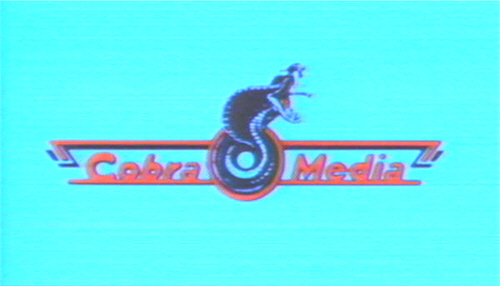
Don’t think you can get around me like that.
We can only hope.
Cue footage from Pandin Wippayoke, as a small island is torn apart by a hurricane in a perfectly respectable display of kaiju eiga-level special effects. In the middle of this, we see by the light of some impressive lightning flashes what appears to be a perfectly ordinary, and rather small, crocodile slip into the water.
(In fact, there are several crocodiles in this sequence, all the same size, which opens up some interesting possibilities.)
Like many killer animal films, including some with an infinitely larger budget than this one, Crocodile is quite unable to settle upon a size for its star, which zig-zags between unthreateningly normal and ludicrously gigantic and back again for the duration. The hurricane is later blamed upon some nearby atomic testing; we are apparently meant to chalk up the crocodile’s size to that, too (though I don’t consider the evidence strong enough to shift this review from ‘killer animal’ to ‘science fiction’).
We are then introduced to our human characters: Dr Anthony Akom, his wife, Angela, and their daughter, Anne; Angela’s sister, Linda; and Linda’s fiancé, and Dr Akom’s colleague, Dr John Strong.
Mrs Akom is trying to persuade her husband to take time off work, so that they can spend a weekend at a resort with John and Linda—the context suggesting that John and Linda will be at the resort on their honeymoon. Dr Akom promises to try, nothing more, and various complaints and warnings then issue from Mrs Akom about doctors being married to their work and exactly what Linda can expect once the honeymoon is over. The telephone rings, and sure enough Dr Akom is summoned back to work. “I’ll come with you!” exclaims Dr Strong, leaping to his feet with an alacrity that suggests that Angela’s gloomy prognostications have a sound basis; although as it turns out, her husband’s work habits will be the least of Linda’s worries.

The beginning of a remarkable motion picture career.
In fairness to Dr Akom, the film that follows suggests fairly strongly that there is only one hospital in Thailand, since casualties pour into it no matter where in the country (or outside of it) an incident occurs; so perhaps we can forgive his over-devotion to duty.
We cut away briefly for some stock footage of ducks and for the first deployment of one of the touches that makes me think that someone saw Orca, an ominous close-up of a crocodile’s eye: a shot that will reappear throughout the film, and which has the desirable side-effect of concealing the size of the animal in question.
We then cut back to the city for another of this film’s distinguishing marks: shots of emergency vehicles accompanied by that brutally high-pitched siren-sound – EEEEEEEE-OOOOOOOO-EEEEEEEE-OOOOOOOO – which personally I’ve always associated with British cop dramas of the 1970s. Every time there is a crocodile attack in this film, it is punctuated by a ragged jump-cut to ambulances pulling up somewhere or other and the sound of those damned sirens, in a manner that becomes hilarious and intolerable in about equal measure. In fact, you could use this regular intrusion as a basis for a very satisfactory drinking game.
Believe me.
This first time around, the sirens signify ambulances pulling up at Dr Akom’s hospital with victims of the hurricane. Nevertheless, Dr Akom promises Angela that he will get away for their relaxing weekend. (Irony alert!)
The film’s first crocodile killing – killing by the crocodile – follows, with an elderly fisherwoman pulled out of her boat, to the accompaniment of underwater POV footage and another inserted eyeball shot (though a different one).

“I AM A HIDEOUS ATOMIC MUTATION, THE LIVING SYMBOL OF MANKIND’S HUBRIS! And that’s my brother, Fred, who is also a hideous atomic mutation and a living symbol of mankind’s hubris.”
Cut back to the Akom party at their holiday resort, joyously frolicking and laughing uproariously at nothing in that way that invariably presages disaster in a film of this kind; as indeed do shots of Anne wearing the new white bathing suit and carrying the inflatable life-preserver that she begged from her father, so that he, “Won’t have to worry about me going in the water alone.” There’s a group photo taken by remote, too, just as the poignant icing on the tragedy cake.
Anyway, we suddenly cut to Linda running towards the water calling out for Anne, who is nowhere to be seen. (Nor, for that matter, is anyone else: both the beach at this “resort” and the waters surrounding it are suddenly mysteriously deserted.) Linda runs into the water calling her niece’s name in increasing desperation, but the only answer she gets is the abrupt resurfacing of the rubber floatie: a touch that conjures up a vision of a sixty-foot killer crocodile sitting under the water with a child’s toy in its jaws and snickering quietly to itself as it waits for the dramatically appropriate moment to release the object.
A series of POV shots then suggests the approach of the crocodile which, pardon me for mentioning it, seems inordinately interested in Linda’s crotch. Of course, what this means in reality is that there is a sixty-foot-long crocodile about six inches away from her, and Linda can’t see it. Sure enough, Linda is pulled under, but struggles and screams and resurfaces in a manner not likely for the victim of an animal as big as this one is supposed to be.
As it happens, the only other person in the vicinity is Angela, who rushes into the water in an attempt to rescue her sister. She too ends up being pulled under in a manner that does not in the least suggest a crocodile attack.
Cut to later on. As sirens blare on the soundtrack – EEEEEEEE-OOOOOOOO-EEEEEEEE-OOOOOOOO – The Authorities search the waters near the resort in a boat. They eventually find Linda – bits of her, anyway: “They only knew it was her because of the engagement ring on her finger!” – and take the curious course of placing them on a stretcher, under a sheet, on the footpath in front of the resort.

You’re all doomed! DOOMED!!
A couple of reporters rush in to peek under the sheet – various “Oh-ew!” noises on the soundtrack – and the policemen supposedly guarding the remains somewhat belatedly shoo them away, one of them saying in a scolding voice, “Don’t look!”
Thwarted on this front, the reporters descend upon the traumatised Dr Strong, while sirens blare in the background, and Dr Akom skulks in his motel room, chewing on the stem of his pipe and contemplating the photographic reminders of the earlier joyous frolicking. He then replays a taped message from Anne, in which she yet again whines for a white bathing suit. Dr Akom starts having all sorts of flashbacks about the bathing suit and the life preserver, and finally reels away from the tape recorder with his hands clamped over his ears. We don’t blame him a bit, this being one of filmdom’s less convincing adult-pretending-to-be-a-child bits of dubbing.
This scene also highlights one of Crocodile’s more curious touches: all of Dr Akom’s trauma is centred in his daughter. As far as we know, he never gives his wife another thought. I guess that’ll teach her to nag her husband about his work. If, you know, getting eaten by a giant crocodile didn’t.
Dr Akom then smashes the tape recorder, which is supposed to signal his descent into an obsession bordering on madness; although the leisurely pace of the film suggests rather a hobby towards which he feels lukewarm at best. His first step is to resign from the hospital (irony alert!), at the same time accepting his superiors’ offer of “facilities”. What exactly these “facilities” consist of is left to our imagination: we next see Dr Akom striding along carrying something that leaves a blood trail behind him (!), and then examining the little that’s left of Linda (!!). Amusingly, Dr Akom is photographed through these sequences in a manner that would imply in another context a body-snatching mad scientist, while some of the lighting effects briefly suggest that we’ve wandered into a Mario Bava film, but no such luck.
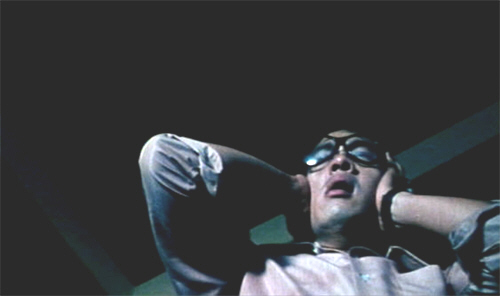
“Those – damn – SIRENS!!”
The remark about Linda’s engagement ring hints that the sheet-swathed object in the morgue is her arm; an inference given gruesomely funny reinforcement when a group of horrified fishermen bring to the surface a net full of arms—just arms. Picture if you will a sixty-foot crocodile fastidiously spitting out this particular section of the human anatomy.
Meanwhile, Dr Akom is visiting the optometrist (?) when he sees a newspaper story about the sighting of a giant crocodile.
A stock footage insert follows, in which Sompote Sands shows us a perfectly ordinary monkey perched on the crocodile’s tail eating a crab, in a manner that somewhat undermines this film’s freakishly-gigantic-atomic-mutation premise.
Cut back to Dr Akom researching crocodiles, and his conclusion that a giant crocodile is responsible for – as he somewhat tactlessly puts it, given that he’s talking to Dr Strong – “Those pieces of anatomy.” This leads to one of the film’s funnier touches, everyone gasping in shocked disbelief at the very idea of a crocodile living in the sea. Indeed, even Dr Akom can’t quite believe it, though it’s his own theory, so he consults an expert:
Expert: “Let me see, now: you mentioned something about a crocodile. Tell me, what is it you want to know? If I can help you, I will.”
Dr Akom: “Well, sir, can a crocodile— Can he live in the sea?”
Expert: “Hmm… That’s a very interesting thought!”
Cut.
(!?)

If you ask me, this crocodile’s a bit of a perv…
Crocodiles not only can live in the sea, they often travel enormous distances by swimming, which accounts for the fact that there are colonies of them on many of the islands in the Pacific and Indian Oceans. Why anyone would think of a crocodile being able to live in the sea as a shocking new ability brought on by atomic mutation, I have absolutely no idea.
Two more girls get chomped to death here. They are wearing bikinis, although I suspect this might be alternate-cut footage of the opening of the “international” version of Crocodile.
Cut to sirens blaring, and worried authority figures doing not much, and then to Dr Akom back in the morgue, although what he’s doing there is anyone’s guess. The strain is briefly too much for him: he collapses, and then staggers to his feet with Anne’s whiny voice in his head.
Dr Akom then calls the world’s shortest and least successful press conference : “You may laugh at me, but it’s a giant crocodile!” “Ha, ha, ha, ha, ha!” “Get out!”
Dr Strong has better luck, rounding up Tanaka, the fisherman who saw the giant crocodile – whose boat looks “quite sturdy”, we’re told – and who agrees to sign on as the film’s Quint character and get gruesomely eaten.
(Oh, like that’s a spoiler.)
Tanaka is quite a figure though, carrying a tattoo of an eagle on his chest and spouting a “legend” about “a monster that rises from the sea” and encounters “the wings of an eagle” – not one scrap of which ever gets referenced again – not even when Tanaka gets gruesomely eaten.

…he’s also a leg-man.
The butchering of the crocodile follows, evidently the price we pay for the destruction of the riverside village. In this version, there is an underwater POV shot, an eyeball shot, and then the carnage begins in a glorious mishmash of poorly disguised miniatures, stock footage, fake blood and enthusiastic extras thrashing in the water.
However, along with many amusing moments, there are some effective ones, too – particularly an underwater shot of a struggling villager with both legs missing (in fact, I doubt he’d be struggling so hard under the circumstances), his ragged injuries suggesting an actual crocodile attack, rather than that the Surgical Tiger is in town. Piers are knocked into the water, houses tip over, people scream and flail (an oddly large proportion of them white, an explanation for which is later provided).
The crocodile, roaring loudly, uses its tail to smash buildings, create waves, and send people flying through the air. It creates a whirlpool in the water, which sucks even more victims down into its maw, and then, as a climactic pièce de résistance, somehow manages to set a building on fire (another seeming reference to Orca).
Cut to sirens blaring in the aftermath, the EEEEEEEE-OOOOOOOO ambulance noises supplemented by even more annoying WOWOO-WOWOO-WOWOO police car noises. “I want all the ambulances you can get!” some sadistic bastard shouts into a walkie-talkie.
(This was, I believe, the moment while watching Crocodile when I happened to glance at my cat, curled up but definitely not sleeping in an armchair—instead, glaring at the television with her ears flicking back and forth in irritation, in perfect tempo with the sirens.)
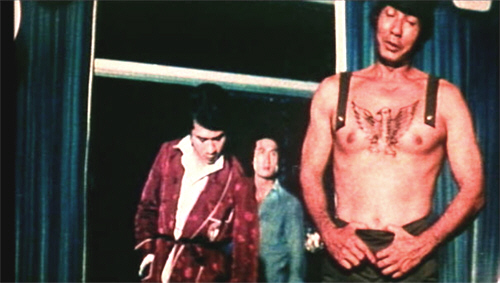
“Sure, it hurts like a bitch; but look how it frames my tattoo!”
Dr Akom and Dr Strong, apparently feeling no particular urge to pitch in and help with the massive casualties from the attack, walk off debating how big the crocodile might be. “It destroyed that village as if it were a toy!” exclaims Akom in what is, all things considered, a rather unfortunate comparison. Dr Akom has also received a letter from his tame expert:
Dr Akom: “After studying the problem, he has come to the conclusion that this creature is the result of all this atomic testing going on in our atmosphere. He feels – and I agree – that our giant crocodile is a mutant.”
Dr Strong: “By God, a mutant!”
<Morbo> “ATOMIC MUTATION DOES NOT WORK THAT WAY!!” </Morbo>
A police inspector – the sadistic bastard wanting more ambulances, I think – stares gloomily into a pit of small crocodiles at a zoo and concludes that Dr Akom is right. His subordinate – who for no reason we ever grasp is in board-shorts and soaking wet – is given the task of catching the crocodile.
This exchange leads to an hilarious scene of three divers, presumably including the young cop, trying to set an underwater trap—using a whacking big metal device exactly like a bear-trap, or a man-trap, whichever expression you prefer. We are given a lingering close-up of the thing, which its construction can hardly support. We then discover that however whacking big it is, it isn’t whacking big enough: the crocodile manages to get the end of its tail caught in the thing, the relative scales indicating that the animal must be pushing one hundred feet long!
As the policemen scream in terror in a mass of air bubbles, the crocodile pulls loose not merely the trap but the tree and the floating drums to which it is anchored and swims away—the dragging of the barrels in its wake distinctly suggestive of the dragging of some barrels in some other killer animal film… The crocodile goes one better, however, managing to shake its load free and, with a flick of its tail, send it flying through the air, decapitating a stand of palm trees in the process.






Take that, Orca!
Dr Akom, meanwhile, is conducting a series of experiments that have no bearing on anything, but are at least science-y enough to hold my interest. He has a small crocodile, and keeps pouring solutions into the water in its tank. (He may be trying to pollute it to death, which isn’t very original.) “It’s not working,” complains Dr Strong. “What do we do now?”
(To which the film’s ultimate answer turns out to be, blow it up.)
(Oh, like that’s a spoiler.)
First, however, there is a charming interlude in which three swimming children get chomped. Evidently the people of Thailand have a shorter time-frame around when they think it’s safe to go back in the water than Americans do.
(Mind you, these days the kids’ casual nakedness raises eyebrows as much as their casual despatching.)
We then get the attack upon the “second” village—that is, the first half of the attack on the village from the original cut of the film. Not only are all the people who “died” in the first attack amusingly in evidence, but we can see that the numerous white people are all part of tour groups; and perhaps in the original cut, this was intended as a piece of commentary.
(Also, if these people were there to be “entertained” by the crocodile butchering, then they get exactly what they deserve.)
The crocodile looms up through what must be the world’s biggest water-weeds, and immediately uses its tail to create a whirlpool. Instantly, the water is full of blood; whose, we can’t imagine. The white people scream and run – except for the ones that stop to take photographs – as the crocodile destroys piers, walkways and buildings with its tail. A forest of severed limbs – mostly arms, we notice – drifts past the camera. That same building catches on fire again, and this time we get a lovely shot of the crocodile’s tail waving in front of it, offering again a sense of scale, or the lack thereof.

Quint Stober Paraday Tanaka Hooper Scott Seberg Strong Brody Kelly Rill Akom.
Cut to sirens blaring. The surviving victims of this second village attack, many of whom look suspiciously similar to the surviving victims of the first village attack – particularly the gentleman in the shirt of multi-coloured squares – are transported to hospital.
In a police car, the inspector and his subordinate look miserably on. The younger cop pats his chief consolingly on the shoulder, pointing out, “You did try” – which I’m inclined to consider fair comment: how on earth this situation is a matter for the police, let alone a single inspector and his loyal sidekick, is rather a mystery; yet as far as we know, they’re the only ones beside Akom and Strong to lift a finger. “No-one will ever kill it!” cries the young cop, shaking his fists and grimacing.
Back to Dr Akom’s, where Dr Strong is either preparing a chum bucket or cooking dinner: the sinister music suggests the former, but the alcohol content suggests the latter. Dr Akom shows Dr Strong a newspaper report of the destruction of the village, commenting that the crocodile seems to attack every three days. It then occurs to the doctors – not to The Authorities, not to The Experts – that they can map the creature’s movements and predict its next appearance – “Where the sea meets the river.”
But first we get the revolting encounter of crocodile and water buffalo. Yeccchhh.
Our triumvirate sets out on Tanaka’s “sturdy” boat (though if you ask me, it could be bigger…), which has been fitted out with a harpoon, and carries a light machine-gun and a case of dynamite – “Complete with fuses”. Akom picks his spot and they start baiting hooks and chumming the water…and throwing marker barrels overboard.
Akom, rifle in hand, then climbs into the lookout tower while Strong mans the harpoon. “All we can do now is wait,” proclaims Akom—and wait they do, us along with them.

Where do they get their ideas…?
Hey, pads out the running-time.
In an object lesson in being careful what you pray for, the monotony is rather horrifyingly disrupted by the belated arrival of the Odious Comic Relief: an obnoxious photographer who has gotten wind of the plan to kill the crocodile and is determined to thrust himself upon the Heroic Trio. He arrives in a small boat and announces his purpose by chortling over the fact that he has “left his wallet in his other pants” and asking the others to pay off the man who piloted him out there.
Astonishingly enough, despite the fact that they expect the crocodile to be coming towards them – despite the fact that they are baiting the water so that it does – Our Heroes do just pay the boatman off and send the poor doomed bastard on his way. Shards of his boat turn up a little while later, accompanied by bits of things that “look human”. Nice going, fellas!
Our regular monotony is then resumed. Night falls (all the better to disguise some rather dodgy model-work [well…not really]), and Our Heroes cap off their day by falling asleep – some of them while drunk – and leaving no-one on watch.
At length, the crocodile’s roaring wakes them up—along with the pitching of the boat in the waves and whirlpools it creates. Then, in a moment so glorious the fact that it is also completely inexplicable becomes quite unimportant, the crocodile launches itself out of the water and jumps over the boat. It is a scene that almost makes the rest of this nonsense worth sitting through, the kind of thing that inspires you to spend hours trying to get a decent screenshot (although you generally fail, sad to say).
The crocodile’s tail slams the boat, which has the effect of jamming the doors and trapping Akom, Strong and Peter the photographer below decks. They cry out for Tanaka to help them, but he’s got problems of his own.

So much for the wings of an eagle.
The crocodile jumps the boat again, but this time we only get to see it launching and landing, not flying through the air. It then swings its tail and knocks Tanaka into the water. He scrambles desperately up the ropes and back on deck, but the crocodile leans in and picks him off with the utmost ease. It chomps on him a few times as he struggles and screams, and then dives under the water.
Meanwhile, possibly realising that this crocodile attack needs a proper conclusion, and that the police cars and ambulances are too far away to get the job done, the survivors set off the boat’s distress alarms, which make a WHOOP-WHOOP noise at an appropriate level of annoying-ness.
Abruptly, it is then morning, and the trapped men have somehow released themselves. Akom is greatly distressed by Tanaka’s fate, and even Peter the photographer is sobered; while Strong takes out his feelings by getting in a little machine-gun practice. The men bait the water again, and sure enough, the crocodile shows up. Akom fires the machine-gun at it, while Strong tries to get a shot with the harpoon. The crocodile seems unbothered by the barrage and simply rises and sinks in place several times with its mouth open—almost as if it weren’t capable of any other movement.
*Cough*
The animal does react when Strong gets off a harpoon shot into its snout, though, and dives with a flailing of its tail. For some reason Our Heroes react as if the battle was all over: Akom climbs down from the lookout with a cheery, “You got him, John!”, while Strong collapses in a mixture of laughter and tears. Peter takes a moment to seal his film in a plastic bag, which he attaches to a life-jacket.
Suddenly the boat is slammed from underneath, sending the men flying and the life-jacket, too. In an amusing twist on all those scenes where someone falls overboard and resurfaces a ridiculous distance from their boat, we are giving a glimpse of Peter’s photos floating about a hundred yards away.

It’s the best I could do, honest.
“We didn’t kill it! It’s only wounded!” cries Akom in dismay. Well, duh.
As they wait – and wait – Strong prepares a bundle of dynamite. Then the crocodile, yet again, bumps the boat from underneath, and Strong, who still hasn’t learned to hang onto something, is tossed into the water. Akom keeps up covering machine-gun fire while Peter tries to help Strong back in, but the crocodile bumps the boat again so that Peter falls in too. It is Strong who becomes the animal’s victim, however.
The crocodile then attacks the boat in good earnest, and it begins to sink—one end of it being dragged down into the water. Hmm. The boat then tips over so that, as he clings to the lookout tower, Dr Akom is almost lying on the water. Hmm. He tries to use dynamite to kill the crocodile, but this fails.
And then a most curious thing happens: Peter lights the fuse on another bundle of dynamite and jumps into the water. (We’ll give them the benefit of the doubt and assume they had the right kind of fuses.) As Akom cries out in protest, Peter swims towards the crocodile and allows himself to be eaten.
There is a short delay, and then—KA-BOOM!!
We see a rescue boat approaching the scene – I’d be willing to bet that Gloomy Inspector and Board-Shorted Sidekick are in it, rather than anyone with actual authority – but then the film just ends, leaving us with no real idea of whether Dr Akom survived or not.
Yeah, you’re right. Who cares?


Crocodylus porosus inflammabilis.
Footnote: I cannot recommend strongly enough the series of articles on the films of Sompote Sands at Die, Danger, Die, Die Kill!, which in typically perverse fashion focus on Crocodile less than anything ever written about Sompote Sands. (All reappearances of the croc-prop are religiously noted, however.) They start here.
♦♦♦♦♦♦♦♦♦♦♦♦♦♦♦♦♦♦♦♦♦♦♦♦♦♦♦♦♦♦♦♦♦♦♦♦♦♦♦♦♦♦♦♦♦♦♦♦♦♦
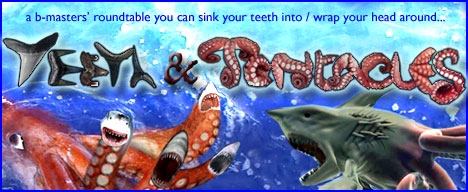
This review was part of the B-Masters’ TEETH & TENTACLES Roundtable.

I have to wonder, wouldn’t a human be rather tiny in comparison to an animal 100 feet long? Like so tiny in comparison that even a large number of them wouldn’t be capable of giving it a decent meal? You’d imagine it’d swim off into the ocean to eat whales and great white sharks or something. Of course in this case we’d not have a story but I think we can all agree, that wouldn’t be a bad thing when it comes to Crocodile.
LikeLike
Well at least a gargantuan crocodile could learn to hunt comparatively tiny humans if they’re a reliable food source. Much like wolves sometimes mostly caught rodents (like in the 1983 movie Never Cry Wolf).
It’d be a different matter for some more primitive predators that are “programmed” to recognize animals within a particular range of sizes or shapes as food. A warehouse-sized black widow spider, for example, would ignore humans as prey if it had the hunting instincts of the normal-sized version. They’re just too small for the colossal Latrodectus to bother with.
LikeLike
Isn’t this where we trot out the whale shark / plankton analogy?
And yes, I do mean that this crocodile DOES NOT EAT ENOUGH PEOPLE!!:D
LikeLike
It’s not a first rate killer animal unless it downs a helicopter. My standards are high. (No laughing at the back there.)
Those posters do go out of their way to suggest what the attractions of the film would be. Does the buxom redhead in a red evening dress ever actually make an appearance, or did she have better sense?
LikeLike
Laughing? – who, me!?
Neither the buxom red-head nor the blonde with the buzz-cut: they both had far too much sense.
LikeLike
So I’ve been rereading some older reviews that haven’t been updated here, as I sometimes do. I just got done reading one a few minutes ago, and I decided my next reread would be Orca, so I came here. To my delight, I see that Lyzzy’s reposted one of her older reviews to her current site!
And it’s Crocodile.
The same one I literally just got done reading.
Even I am disquieted at this point.
Anyway. Some of these posters…good lord. Especially that one that makes it look like a Cinemax feature.
I still haven’t seen this. I probably should; I’m sure I’ve seen worse killer crocodilian movies (thanks, Asylum!) At least this one has props instead of craptastic CGI.
I love that “hideous atomic mutation” joke, and of course the last one. I’m also happy you preserved that particular Roundtable pic, since it was inspired by a comment I made, which was sadly lost when the B-Masters site went…well, inflammabilis, shall we say.
LikeLike
…doo-doo-doo-doo, doo-doo-doo-doo… 😀
Though of course Crocodile was the next logical step of the existing material. And although my reasons were (I hope) cogent, it could be argued that I’ve skipped The Great Alligator River; so I guess we’ve all got something to look forward to!
That’s some great cover art, isn’t it?? Those images were all associated with Crocodile, but it’s pretty clear in some cases that the latter was being confused with Killer Crocodile.
Don’t go out of your way to see this, though.
Many unexpected things go inflammabilis…
LikeLike
Well, any review of yours is something to look forward to, my dear.
I will not make any more effort than I had been to see this, I guess. Maybe I’ll just watch Crocodile Fury again.
I feel like there’s an obvious joke to be made about unexpected things going inflammabilis but I think it’ll just depress me to do so.
LikeLike
My favorite poster is the Desert Island Classic, which doesn’t promise any non-existent evening gowns. I think the little fellow is laughing at the thought of how stupid this movie is.
LikeLike
I like to think that’s Fred, making the most of his 15 minutes. 🙂
LikeLike
“Most famously, it opens with a gratuitous and completely out-of-place scene in which the giant crocodile (not yet created by atomic mutation) chows down on two topless young women. ”
That sounds like the intro to Shaw Brother’s BLACK MAGIC PART II, which appears to have been filmed in Thailand.
LikeLike
Ah! – noted, thanks.
LikeLike
And now I’ve seen it, no it’s not from Black Magic II!
I do wonder if HK’s Shaw Brothers had some involvement in this, given actress Tanny was contracted to them.
LikeLike